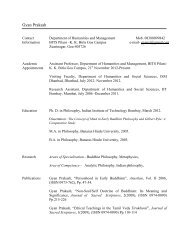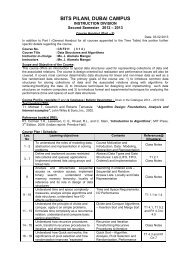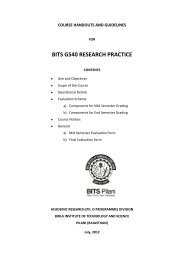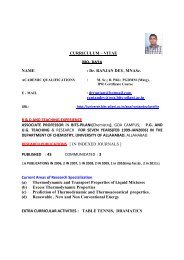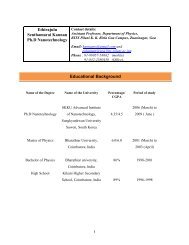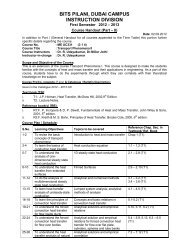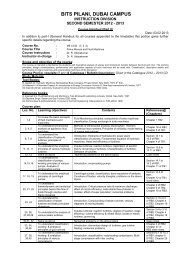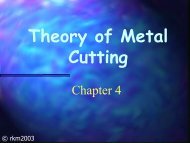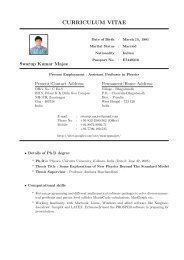Lathe
Lathe
Lathe
- No tags were found...
Create successful ePaper yourself
Turn your PDF publications into a flip-book with our unique Google optimized e-Paper software.
Turning OperationsChapter 5L a t h e© rkm2003
Turning OperationsMachine Tool – LATHEJob (workpiece) – rotary motionTool – linear motions“Mother of Machine Tools “Cylindrical and flat surfaces© rkm2003
Some Typical <strong>Lathe</strong> JobsTurning/Drilling/Grooving/Threading/Knurling/Facing...© rkm2003
S pindlespeedselectorF eed changegearboxThe <strong>Lathe</strong>H ead stockS pindleG uide w aysT o ol postC ro ss slideD ead centerT ailstock quillT ailstockH andleC om pound restand slide(sw ivels)B edC arriageA pron© rkm2003F eed rodL ead screw
The <strong>Lathe</strong>Head StockTail StockBed© rkm2003Feed/Lead ScrewCarriage
Types of <strong>Lathe</strong>sEngine <strong>Lathe</strong>Speed <strong>Lathe</strong>Bench <strong>Lathe</strong>Tool Room <strong>Lathe</strong>Special Purpose <strong>Lathe</strong>Gap Bed <strong>Lathe</strong>…© rkm2003
Size of <strong>Lathe</strong>Workpiece LengthSwing© rkm2003
Size of <strong>Lathe</strong> ..© rkm2003Example: 300 - 1500 <strong>Lathe</strong>Maximum Diameter of Workpiecethat can be machined= SWING (= 300 mm)Maximum Length of Workpiecethat can be held betweenCenters (=1500 mm)
Workholding DevicesEquipment used to holdWorkpiece – fixturesTool - jigsSecurely HOLD or Support whilemachining© rkm2003
ChucksThree jaw Four JawWorkholding Devices ..© rkm2003
Workholding Devices ..Headstock center(Live Centre)CentersWorkpieceTailstock center(Dead Centre)© rkm2003
Workpiece© rkm2003FaceplatesWorkholding Devices ..
© rkm2003DogsTailTailWorkholding Devices ..
Workholding Devices ..MandrelsWorkpiece (job) with a holeWorkpieceMandrel© rkm2003
Workholding Devices ..© rkm2003RestsSteady Rest Follower RestWorkJawsHingeWork JawsCarriage<strong>Lathe</strong> bed guideways
Operating/CuttingConditions1. Cutting Speed v2. Feed f3. Depth of Cut dTool postWorkpieceN (rev/min)Chip© rkm2003ToolDSperipheralspeed (m/min)
Operating ConditionsTool postChipWorkpieceN (rev/min)ToolDSperipheralspeedrelativetooltravelin 1 rotation =πDperipheralspeed=S=πD N© rkm2003
Operating Conditions..Cutting SpeedD – Diameter (mm)N – Revolutions per Minute (rpm)v=πD N1000m/minThe Peripheral Speed ofWorkpiece past the Cutting Tool=Cutting Speed© rkm2003
Operating Conditions..© rkm2003Feedf – the distance the tooladvances for every rotation ofworkpiece (mm/rev)D1D2fFeed
Operating Conditions..© rkm2003Depth of Cutperpendicular distance betweenmachined surface and uncutsurface of the Workpieced = (D 1 – D 2 )/2 (mm)D1D2d Depthof Cut
3 Operating ConditionsCutting speedWorkpieceChuck© rkm2003NFeed (f )ToolDepth of cut (d)MachinedsurfaceChipDepth of cut
Operating Conditions..Selection of ..Workpiece MaterialTool MaterialTool signatureSurface FinishAccuracyCapability of Machine Tool© rkm2003
Operations on <strong>Lathe</strong> ..Material Removal Rate© rkm2003MRRVolume of material removed in onerevolution MRR = π D d f mm 3• Job makes N revolutions/minMRR = π D d f N (mm 3 /min) In terms of v MRR is given byMRR = 1000 v d f (mm 3 /min)
Operations on <strong>Lathe</strong> ..MRRdimensional consistency bysubstituting the unitsMRR: D d f N (mm)(mm)(mm/rev)(rev/min)= mm 3 /min© rkm2003
Operations on <strong>Lathe</strong> ..Operations on <strong>Lathe</strong>TurningFacingknurlingGroovingPartingChamferingTaper turningDrillingThreading© rkm2003
© rkm2003TurningCylindrical jobOperations on <strong>Lathe</strong> ..
Operations on <strong>Lathe</strong> ..© rkm2003CuttingspeedChuckNTurning ..Cylindrical jobFeedToolWorkpieceDepth of cut (d)MachinedsurfaceChipDepth of cut
Operations on <strong>Lathe</strong> ..Turning .. Excess Material is removedto reduce DiameterCutting Tool: Turning Toola depth of cut of 1 mm willreduce diameter by 2 mm© rkm2003
Operations on <strong>Lathe</strong> ..© rkm2003FacingFlat Surface/Reduce lengthChuckCuttingspeedWorkpieceTooldMachinedFaceFeedDepth ofcut
Operations on <strong>Lathe</strong> ..© rkm2003Facing .. machine end of job Flat surfaceor to Reduce Length of Job Turning Tool Feed: in direction perpendicular toworkpiece axisLength of Tool Travel = radius ofworkpiece Depth of Cut: in direction parallel toworkpiece axis
© rkm2003Facing ..Operations on <strong>Lathe</strong> ..
Operations on <strong>Lathe</strong> ..Eccentric Turning4-jawchuckCuttingspeedAxis of jobEccentric peg(to be turned)Ax© rkm2003
Operations on <strong>Lathe</strong> ..KnurlingProduce rough textured surfaceFor Decorative and/orFunctional PurposeKnurling Tool A Forming ProcessMRR~0© rkm2003
Operations on <strong>Lathe</strong> ..CuttingspeedKnurlingKnurling toolFeedTool postKnurled surfaceMovementfor depth© rkm2003
© rkm2003Knurling ..Operations on <strong>Lathe</strong> ..
Operations on <strong>Lathe</strong> ..GroovingProduces a Groove onworkpieceShape of tool shape ofgrooveCarried out using GroovingTool A form toolAlso called Form Turning© rkm2003
Operations on <strong>Lathe</strong> ..Grooving ..Shape producedby form tool GrooveForm toolFeed ordepth of cutGroovingtool© rkm2003
Operations on <strong>Lathe</strong> ..PartingCutting workpiece into TwoSimilar to groovingParting ToolHogging – tool rides over – atslow feedCoolant use© rkm2003
Operations on <strong>Lathe</strong> ..© rkm2003Parting ..Parting toolFeed
Operations on <strong>Lathe</strong> ..© rkm2003ChamferingChamferChamfering toolFeed
Operations on <strong>Lathe</strong> ..ChamferingBeveling sharp machined edgesSimilar to form turning Chamfering tool – 45°ToAvoid Sharp EdgesMake Assembly EasierImprove Aesthetics© rkm2003
Operations on <strong>Lathe</strong> ..© rkm2003Taper TurningTaper:D 1BAtan α =αLD90°1−2LCD2Dα 2
Operations on <strong>Lathe</strong> ..Taper Turning..ConicityKMethods Form Tool=D Swiveling Compound Rest Taper Turning Attachment Simultaneous Longitudinal andCross Feeds1 −LD2© rkm2003
Operations on <strong>Lathe</strong> ..Taper Turning ..By Form ToolWorkpiece TaperαStraight Form Directionof feedcutting edge tool© rkm2003
Operations on <strong>Lathe</strong> ..© rkm2003Taper Turning ,,By Compound RestFace plateTool post &Tool holderCross slideDogαMandrelDirection of feedTail stock quillTail stockCompound restSlideCompound restHand crank
Operations on <strong>Lathe</strong> ..DrillingDrill – cutting tool – held in TS –feed from TSDrillFeedTail stockTail stock clampQuillclampmovingquill© rkm2003
Operations on <strong>Lathe</strong> ..Process SequenceHow to make job from rawmaterial 45 long x 30 dia.?401520 diaSteps:•Operations•Sequence•Tools•Process© rkm2003
Operations on <strong>Lathe</strong> ..Process Sequence ..Possible Sequences TURNING - FACING - KNURLING TURNING - KNURLING - FACING FACING - TURNING - KNURLING FACING - KNURLING - TURNING KNURLING - FACING - TURNING KNURLING - TURNING – FACINGWhat is an Optimal Sequence?XXXX© rkm2003
Operations on <strong>Lathe</strong> ..© rkm2003Machining TimeTurning TimeJob length L j mmFeed f mm/revJob speed N rpmf N mm/mint=fLjNmin
Operations on <strong>Lathe</strong> ..Manufacturing TimeManufacturing Time= Machining Time+ Setup Time+ Moving Time+ Waiting Time© rkm2003
ExampleA mild steel rod having 50 mmdiameter and 500 mm length isto be turned on a lathe.Determine the machining timeto reduce the rod to 45 mm inone pass when cutting speed is30 m/min and a feed of 0.7mm/rev is used.© rkm2003
ExampleGiven data: D = 50 mm, L j = 500 mmv = 30 m/min, f = 0.7 mm/revSubstituting the values of v and D inv=πD N1000m/min© rkm2003calculate the required spindlespeed as: N = 191 rpm
ExampleCan a machine has speed of191 rpm?Machining time:t=Ljf Nmint = 500 / (0.7×191)© rkm2003= 3.74 minutes
Example© rkm2003 Determine the angle at which thecompound rest would be swiveledfor cutting a taper on a workpiecehaving a length of 150 mm andoutside diameter 80 mm. Thesmallest diameter on the taperedend of the rod should be 50 mmand the required length of thetapered portion is 80 mm.
Example Given data: D1 = 80 mm, D2 = 50mm, Lj = 80 mm (with usualnotations)tan α = (80-50) / 2×80 or α = 10.620 The compound rest should beswiveled at 10.62 o© rkm2003
Example© rkm2003 A 150 mm long 12 mm diameterstainless steel rod is to be reducedin diameter to 10 mm by turning ona lathe in one pass. The spindlerotates at 500 rpm, and the tool istraveling at an axial speed of 200mm/min. Calculate the cuttingspeed, material removal rate andthe time required for machining thesteel rod.
Example Given data: Lj = 150 mm, D1 = 12mm, D2 = 10 mm, N = 500 rpm Using Equation (1) v = π×12×500 / 1000= 18.85 m/min. depth of cut = d = (12 – 10)/2 = 1mm© rkm2003
© rkm2003Example feed rate = 200 mm/min, we getthe feed f in mm/rev by dividingfeed rate by spindle rpm. That isf = 200/500 = 0.4 mm/rev From Equation (4), MRR = 3.142×12×0.4×1×500 =7538.4mm3/min from Equation (8),t = 150/(0.4×500) = 0.75 min.
Example© rkm2003 Calculate the time required tomachine a workpiece 170 mm long,60 mm diameter to 165 mm long50 mm diameter. The workpiecerotates at 440 rpm, feed is0.3 mm/rev and maximum depth ofcut is 2 mm. Assume totalapproach and overtravel distanceas 5 mm for turning operation.
ExampleGiven data: Lj = 170 mm, D1 =60 mm, D2 = 50 mm, N = 440rpm, f = 0.3 mm/rev, d= 2 mm,How to calculate the machiningtime when there is more than oneoperation?© rkm2003
© rkm2003Example Time for Turning: Total length of tool travel = job length + lengthof approach and overtravel L = 170 + 5 = 175 mm Required depth to be cut = (60 – 50)/2 = 5mm Since maximum depth of cut is 2 mm, 5 mmcannot be cut in one pass. Therefore, wecalculate number of cuts or passes required. Number of cuts required = 5/2 = 2.5 or 3(since cuts cannot be a fraction) Machining time for one cut = L / (f×N) Total turning time = [L / (f×N)] × Number of
Example© rkm2003 Time for facing:Now, the diameter of the job isreduced to 50 mm. Recall that incase of facing operations, length oftool travel is equal to half thediameter of the job. That is, l = 25mm. Substituting in equation 8, weget t = 25/(0.3×440)= 0.18 min.
Example Total time:Total time for machining = Timefor Turning + Time for Facing = 3.97 + 0.18= 4.15 min. The reader should find out the totalmachining time if first facing isdone.© rkm2003
Example© rkm2003 From a raw material of 100 mmlength and 10 mm diameter, acomponent having length 100 mmand diameter 8 mm is to beproduced using a cutting speed of31.41 m/min and a feed rate of 0.7mm/revolution. How many timeswe have to resharpen or regrind, if1000 work-pieces are to beproduced. In the taylor’s expressionuse constants as n = 1.2 and C =
Example Given D =10 mm , N = 1000 rpm,v = 31.41 m/minute From Taylor’s tool life expression,we have vT n = C Substituting the values we get, (31.40)(T)1.2 = 180 or T = 4.28 min© rkm2003
Example Machining time/piece = L / (f×N) = 100 / (0.7×1000)= 0.142 minute. Machining time for 1000 work-pieces= 1000 × 0.142 = 142.86 min Number of resharpenings = 142.86/4.28= 33.37 or 33 resharpenings© rkm2003
© rkm2003Example 6: While turning a carbon steelcylinder bar of length 3 m and diameter0.2 m at a feed rate of 0.5mm/revolution with an HSS tool, one ofthe two available cutting speeds is to beselected. These two cutting speeds are100 m/min and 57 m/min. The tool lifecorresponding to the speed of 100m/min is known to be 16 minutes withn=0.5. The cost of machining time,setup time and unproductive timetogether is Rs.1/sec. The cost of onetool re-sharpening is Rs.20.
© rkm2003Example Given T1 = 16 minute, v1 = 100m/minute, v2 = 57 m/minute, D =200mm, l = 300 mm, f = 0.5 mm/rev Consider Speed of 100 m/minute N1 = (1000 × v) / (π × D) =(1000×100) / (π×200) = 159.2 rpm t1 = l / (f×N) = 3000 / (0.5 ×159.2) =37.7 minute Tool life corresponding to speed of 100m/minute is 16 minute. Number of resharpening required = 37.7 /16 = 2.35
ExampleTotal cost = Machining cost + Cost ofresharpening × Number ofresharpening = 37.7×60×1+ 20×2= Rs.2302© rkm2003
Example Consider Speed of 57 m/minuteUsing Taylor’s expression T2 = T1× (v1 / v2)2 with usual notations = 16 × (100/57)2 =49 minute Repeating the same procedure weget t2 = 66 minute, number ofreshparpening=1 and total cost =Rs. 3980.© rkm2003
ExampleWrite the process sequence tobe used for manufacturing thecomponentfrom raw material of 175 mm lengthand 60 mm diameter© rkm2003
Example20Threading5040 Dia50405020 Dia© rkm2003
Example© rkm2003 To write the process sequence, first listthe operations to be performed. Theraw material is having size of 175 mmlength and 60 mm diameter. Thecomponent shown in Figure 5.23 ishaving major diameter of 50 mm, stepdiameter of 40 mm, groove of 20 mmand threading for a length of 50 mm.The total length of job is 160 mm.Hence, the list of operations to becarried out on the job are turning,
© rkm2003Example A possible sequence for producingthe component would be: Turning (reducing completely to 50mm) Facing (to reduce the length to 160mm) Step turning (reducing from 50 mmto 40 mm) Thread cutting. Grooving




